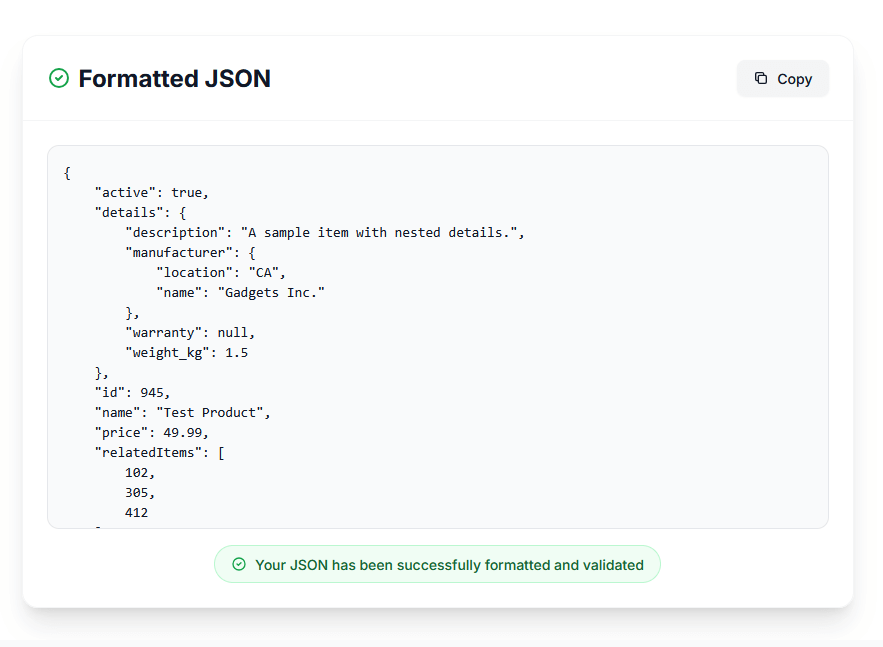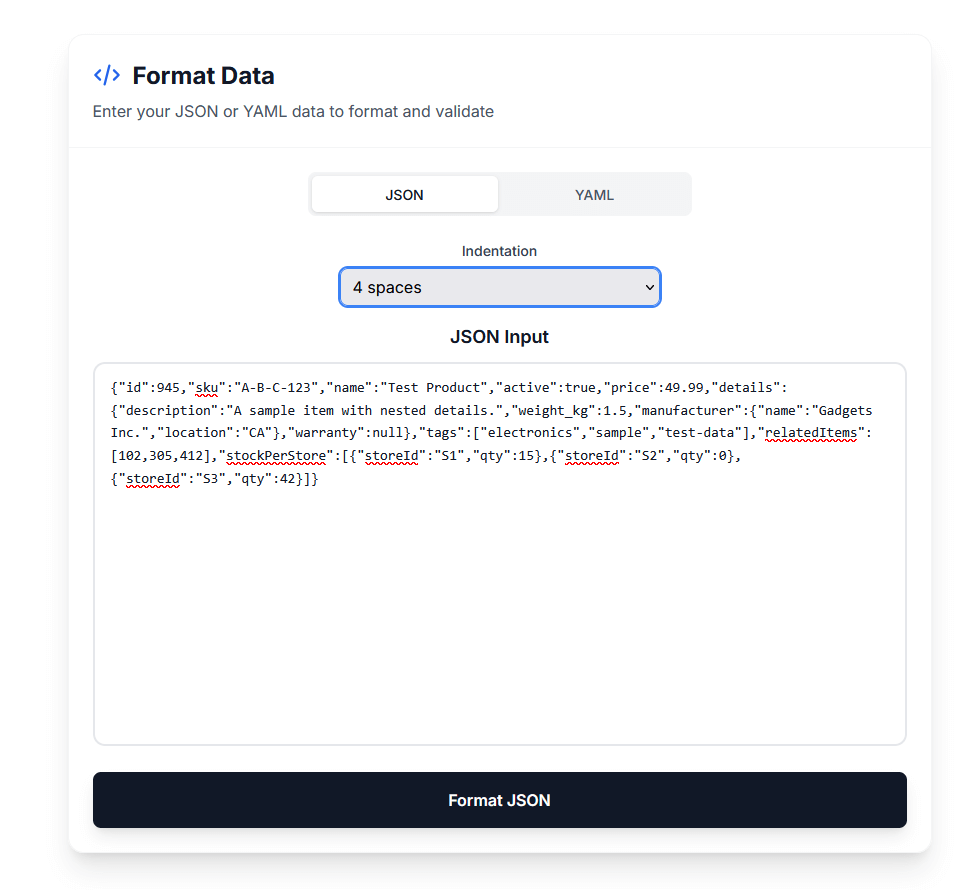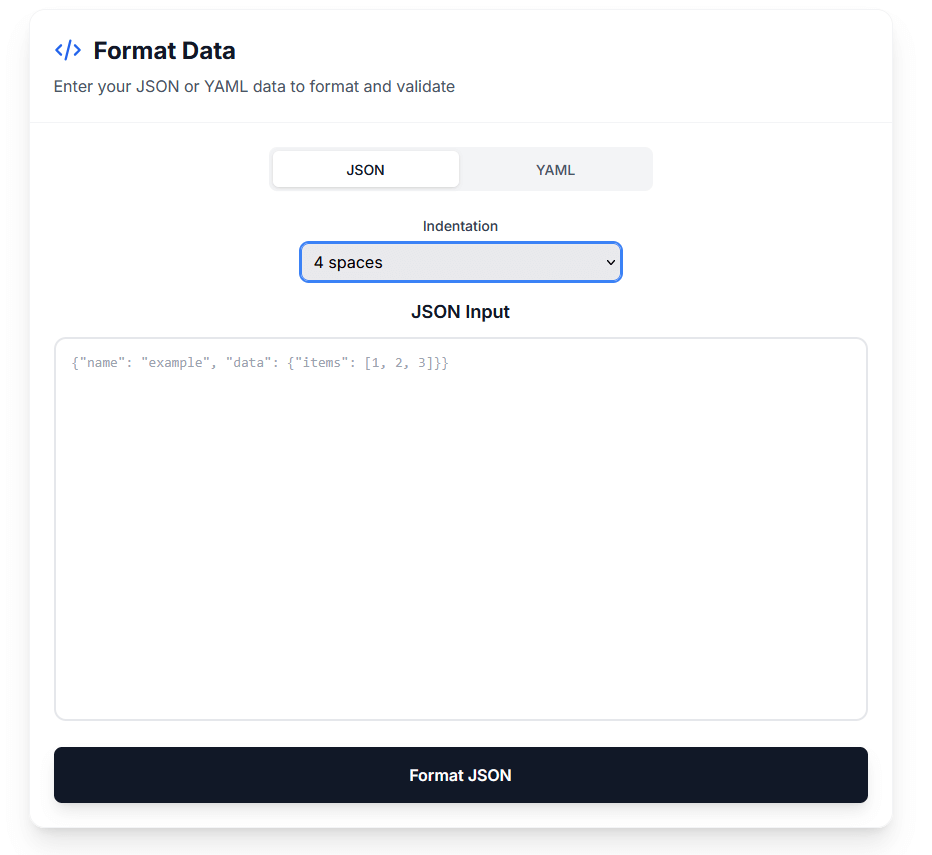How to Format JSON Online: Free Tool & Step-by-Step Guide (2026)
Working with APIs and getting JSON responses that look like a jumbled mess? You’re not alone. Minified JSON is nearly impossible to read, debug, or understand at a glance. That’s exactly why you need a reliable JSON formatter.
In this complete guide, you’ll learn how to format JSON online using our free tool, fix common formatting errors, and apply best practices that will save you hours of debugging time. Whether you’re a backend developer working with REST APIs, a frontend engineer consuming data, or a QA tester validating responses, this guide has you covered.
What is JSON Formatting?
JSON formatting (also called “pretty printing” or “beautifying”) is the process of transforming compact, single-line JSON data into a human-readable format with proper indentation, line breaks, and spacing. This makes the data structure clear and easy to understand.
Why Format JSON?
When you receive JSON data from an API, it’s often minified to reduce file size and bandwidth. While this is great for performance, it makes the data extremely difficult for humans to read and debug. Formatting solves this problem by:
- Improving readability - Nested structures become immediately visible
- Faster debugging - Spot errors and data issues in seconds
- Better collaboration - Team members can quickly understand data structures
- Easier validation - Syntax errors stand out clearly
- Code review efficiency - Formatted JSON shows cleaner diffs in version control
The Problem: Unformatted JSON
Here’s what typical API responses look like before formatting:
{"id":945,"sku":"A-B-C-123","name":"Test Product","active":true,"price":49.99,"details":{"description":"A sample item with nested details.","weight_kg":1.5,"manufacturer":{"name":"Gadgets Inc.","location":"CA"},"warranty":null},"tags":["electronics","sample","test-data"],"relatedItems":[102,305,412],"stockPerStore":[{"storeId":"S1","qty":15},{"storeId":"S2","qty":0},{"storeId":"S3","qty":42}]}
Can you quickly tell what this data contains? How many products? What’s nested? It’s nearly impossible to parse visually.
How to Format JSON Online: Step-by-Step Tutorial
Let’s walk through the exact process of formatting JSON using our free online tool. This works for any JSON data - from simple objects to complex nested structures.
Step 1: Copy Your JSON Data
First, get the JSON data you want to format. This could come from:
- API responses (Postman, cURL, browser console)
- Configuration files
- Database exports
- Code snippets
- Log files
Copy the entire JSON string to your clipboard.
Step 2: Open the JSON Formatter Tool
Navigate to our JSON Formatter tool. You’ll see a clean, distraction-free interface designed for speed:
The interface includes:
- Input field - Paste your JSON here
- Format selector - Choose between JSON and YAML
- Indentation options - Select 2 spaces or 4 spaces
- Format button - One click to beautify
Step 3: Paste and Format
Paste your JSON into the input field. You can also type directly or drag and drop a JSON file. The tool automatically detects your JSON structure.
Click the “Format JSON” button. Our formatter instantly processes your data and displays the beautified result.
Step 4: Review the Formatted Output
Your JSON is now perfectly formatted with proper indentation and structure:
{
"active": true,
"details": {
"description": "A sample item with nested details.",
"manufacturer": {
"location": "CA",
"name": "Gadgets Inc."
},
"warranty": null,
"weight_kg": 1.5
},
"id": 945,
"name": "Test Product",
"price": 49.99,
"relatedItems": [
102,
305,
412
]
}
Notice how much easier it is to understand the data structure now. You can immediately see:
- All top-level properties
- Nested objects and their hierarchy
- Array contents
- Data types (strings, numbers, booleans, null)
Step 5: Copy Your Formatted JSON
Click the “Copy” button to copy the formatted JSON to your clipboard. Now you can paste it into your code editor, documentation, or anywhere else you need it.
Common JSON Formatting Errors and How to Fix Them
Even experienced developers run into JSON syntax errors. Our JSON Formatter automatically catches these issues, but here are the most common problems and their solutions:
Error 1: Missing Commas Between Properties
Incorrect:
{
"name": "John"
"age": 30
"city": "New York"
}
Error Message: Unexpected token 'age'
Fix: Add commas after each property except the last one:
{
"name": "John",
"age": 30,
"city": "New York"
}
Error 2: Trailing Commas
Incorrect:
{
"name": "John",
"age": 30,
"city": "New York",
}
Error Message: Unexpected token '}'
Fix: Remove the comma after the last property:
{
"name": "John",
"age": 30,
"city": "New York"
}
Error 3: Single Quotes Instead of Double Quotes
Incorrect:
{
'name': 'John',
'age': 30
}
Error Message: Unexpected token '''
Fix: JSON requires double quotes for all strings:
{
"name": "John",
"age": 30
}
Error 4: Unescaped Special Characters
Incorrect:
{
"message": "She said "Hello" to me"
}
Error Message: Unexpected token 'H'
Fix: Escape quotes inside strings with backslashes:
{
"message": "She said \"Hello\" to me"
}
Error 5: Comments in JSON
Incorrect:
{
// This is a comment
"name": "John",
"age": 30
}
Error Message: Unexpected token '/'
Fix: JSON does not support comments. Remove them or use a configuration format that supports comments:
{
"name": "John",
"age": 30
}
Note: If you need comments, consider using YAML instead, which supports comments natively.
Real-World Use Cases for JSON Formatting
Understanding when and why to format JSON will help you work more efficiently. Here are the most common scenarios:
Use Case 1: API Response Debugging
When testing REST APIs, responses often come back minified. Format them to quickly identify issues:
{
"status": "success",
"data": {
"users": [
{
"id": 1,
"name": "Alice Johnson",
"email": "alice@example.com",
"role": "admin"
},
{
"id": 2,
"name": "Bob Smith",
"email": "bob@example.com",
"role": "user"
}
],
"total": 2,
"page": 1
},
"timestamp": "2025-01-27T10:30:00Z"
}
Pro Tip: Format and validate your API responses to catch issues quickly during testing.
Use Case 2: Configuration File Management
Application config files benefit from readable formatting:
{
"database": {
"host": "localhost",
"port": 5432,
"name": "myapp_production",
"credentials": {
"username": "db_user",
"password": "${DB_PASSWORD}"
}
},
"cache": {
"enabled": true,
"ttl": 3600,
"provider": "redis"
},
"logging": {
"level": "info",
"format": "json"
}
}
Use Case 3: Data Export and Analysis
When exporting data from databases or APIs for analysis:
{
"report": "Sales Q4 2024",
"metrics": {
"totalRevenue": 1250000,
"customers": 450,
"averageOrderValue": 2777.78,
"topProducts": [
{"id": "P1", "name": "Product A", "sales": 125000},
{"id": "P2", "name": "Product B", "sales": 98000},
{"id": "P3", "name": "Product C", "sales": 87000}
]
}
}
For data analysis workflows, consider using our Data Converter tool to transform JSON data into other formats.
Use Case 4: Documentation and Code Examples
When writing technical documentation or tutorials:
{
"request": {
"method": "POST",
"endpoint": "/api/v1/users",
"headers": {
"Content-Type": "application/json",
"Authorization": "Bearer {token}"
},
"body": {
"name": "New User",
"email": "user@example.com"
}
},
"response": {
"status": 201,
"body": {
"id": "usr_12345",
"created_at": "2025-01-27T10:30:00Z"
}
}
}
Use Case 5: Version Control and Code Reviews
Before committing JSON files to Git, format them for cleaner diffs:
{
"version": "2.1.0",
"dependencies": {
"express": "^4.18.2",
"mongoose": "^7.0.3",
"dotenv": "^16.0.3"
},
"devDependencies": {
"jest": "^29.5.0",
"eslint": "^8.40.0"
}
}
Consistent formatting reduces merge conflicts and makes code reviews faster.
Advanced Formatting Options
Our JSON formatter includes advanced options for power users:
Indentation Styles
Choose between different indentation styles based on your team’s coding standards:
2 Spaces (Default):
{
"name": "Example",
"nested": {
"key": "value"
}
}
4 Spaces:
{
"name": "Example",
"nested": {
"key": "value"
}
}
Tabs:
{
"name": "Example",
"nested": {
"key": "value"
}
}
Sorting Object Keys Alphabetically
Enable key sorting for easier comparison between JSON objects:
Before:
{
"name": "John",
"age": 30,
"city": "New York",
"active": true
}
After sorting:
{
"active": true,
"age": 30,
"city": "New York",
"name": "John"
}
This is particularly useful when comparing configuration files or API responses.
Compact vs. Expanded Arrays
Choose how arrays are displayed:
Compact (single line for simple arrays):
{
"numbers": [1, 2, 3, 4, 5],
"tags": ["tag1", "tag2", "tag3"]
}
Expanded (one item per line):
{
"numbers": [
1,
2,
3,
4,
5
],
"tags": [
"tag1",
"tag2",
"tag3"
]
}
JSON Formatting Best Practices
Follow these best practices to maintain clean, readable JSON across your projects:
1. Use Consistent Indentation
Stick to one indentation style (2 or 4 spaces) across your entire project. This ensures consistency and reduces cognitive load when switching between files.
2. Format Before Committing to Version Control
Always format JSON files before committing to Git. Use pre-commit hooks or linters to enforce this automatically.
3. Validate Before Formatting
Use our JSON Formatter to check for syntax errors before attempting to format. This saves time and prevents confusion.
4. Minify for Production, Format for Development
Keep two versions:
- Development: Formatted with indentation for easy reading
- Production: Minified to reduce file size and improve performance
Use our JSON Formatter to create production-ready minified versions.
5. Add Schema Validation
For complex JSON structures, define a JSON Schema to validate data structure:
{
"$schema": "http://json-schema.org/draft-07/schema#",
"type": "object",
"properties": {
"name": {"type": "string"},
"age": {"type": "number", "minimum": 0}
},
"required": ["name"]
}
Define JSON Schemas to validate your data structures and ensure consistency across your application.
6. Use Descriptive Property Names
Make your JSON self-documenting with clear property names:
Bad:
{
"n": "John",
"a": 30,
"c": "NYC"
}
Good:
{
"fullName": "John",
"ageInYears": 30,
"cityOfResidence": "New York City"
}
7. Keep Nesting Levels Reasonable
Avoid deeply nested structures when possible. Aim for 3-4 levels maximum:
Avoid:
{
"level1": {
"level2": {
"level3": {
"level4": {
"level5": {
"data": "too deep"
}
}
}
}
}
}
Better:
{
"data": "easier to access",
"metadata": {
"created": "2025-01-27"
}
}
Consider restructuring deeply nested data or using references instead.
Why Use Our JSON Formatter?
Our JSON formatter stands out with features designed for modern developers:
Lightning-Fast Performance
Format JSON instantly - no waiting, no delays. Our tool processes files up to 10MB in milliseconds.
100% Client-Side Processing
Your data never leaves your browser. Everything happens locally on your device, ensuring complete privacy and security. This is especially important when working with sensitive API keys, credentials, or proprietary data.
Automatic Validation
Syntax errors are detected and highlighted in real-time. Know exactly what’s wrong and where to fix it.
Syntax Highlighting
Color-coded output makes different data types instantly recognizable:
- Blue: Property names
- Green: String values
- Orange: Numbers
- Purple: Booleans and null
One-Click Copy
Copy formatted JSON to your clipboard with a single click. No need to select text manually.
No Sign-Up Required
Start formatting immediately - no account creation, no email required, no paywalls.
Works Offline
Once loaded, our formatter works without an internet connection. Perfect for developers working in secure environments or traveling.
Mobile-Friendly
Format JSON on any device - desktop, tablet, or smartphone. The responsive interface adapts to your screen size.
Frequently Asked Questions
Is it safe to paste sensitive JSON data into this tool?
Yes, absolutely. Our JSON formatter runs entirely in your browser using JavaScript. Your data is never sent to our servers, stored, or logged. You can verify this by checking your browser’s Network tab - you’ll see no outgoing requests containing your data.
For extra security when working with production credentials, you can use the tool offline or replace sensitive values with placeholders before formatting.
Can I format large JSON files?
Yes, our tool efficiently handles JSON files up to 10MB in size. For even larger files, consider using command-line tools like jq or Python’s json.tool for processing.
Does this work with JSON5 or JSONC?
Currently, our formatter supports standard JSON (RFC 8259). JSON5 features like comments, trailing commas, and unquoted keys are not supported. For standard JSON formatting and validation, our tool works perfectly.
How do I format JSON in my code editor?
Most modern code editors have built-in JSON formatters:
- VS Code: Select JSON text, press
Shift + Alt + F(Windows/Linux) orShift + Option + F(Mac) - Sublime Text: Install the “Pretty JSON” package
- IntelliJ/WebStorm: Right-click → Reformat Code
- Vim: Use
:%!python -m json.tool
For a web-based option that works anywhere, bookmark our tool for instant access.
What’s the difference between formatting and validating JSON?
Formatting improves readability by adding indentation and line breaks. It assumes your JSON syntax is correct.
Validating checks for syntax errors like missing commas, mismatched brackets, or invalid characters. It confirms your JSON is parseable.
Our tool does both simultaneously. For JSON formatting with validation, use our Formatter tool which checks syntax as it beautifies your code.
Can I integrate this formatter into my workflow?
Yes! We offer a web-based tool that you can bookmark and access anytime. For command-line usage, we recommend tools like jq (for Linux/Mac) or python -m json.tool which are available on most systems.
How do I format JSON in different programming languages?
Here are quick snippets for formatting JSON in popular languages:
JavaScript/Node.js:
const formatted = JSON.stringify(data, null, 2);
console.log(formatted);
Python:
import json
formatted = json.dumps(data, indent=2)
print(formatted)
PHP:
$formatted = json_encode($data, JSON_PRETTY_PRINT);
echo $formatted;
Ruby:
require 'json'
formatted = JSON.pretty_generate(data)
puts formatted
Java:
Gson gson = new GsonBuilder().setPrettyPrinting().create();
String formatted = gson.toJson(data);
For a no-code solution that works anywhere, use our web-based formatter.
Related Developer Tools
Expand your development workflow with our complete suite of tools:
Text & Data Tools
- Formatter - Format JSON, XML, SQL and other code formats
- Converter - Convert between different data formats
- Diff Tool - Compare two text files and highlight differences
- Word Counter - Count words, characters, and analyze text
- Duplicate Remover - Remove duplicate lines from text
- Whitespace Remover - Clean up extra spaces and line breaks
Encoding & Hashing
- Encoder - Encode and decode Base64, URL, HTML and more
- Hash Generator - Generate MD5, SHA-1, SHA-256 and other hashes
- Checksum Calculator - Calculate file checksums
- HTML Entity Encoder - Encode/decode HTML entities
- Encryption Tool - Encrypt and decrypt text securely
Code & Formatting Tools
- XML Formatter - Format and validate XML documents
- SQL Formatter - Beautify SQL queries
- Markdown Previewer - Preview markdown in real-time
- String Case Converter - Convert between camelCase, snake_case, etc.
Generators & Utilities
- UUID Generator - Generate unique identifiers
- Random String Generator - Create random passwords and strings
- Slug Generator - Convert text to URL-friendly slugs
- QR Code Generator - Create QR codes instantly
- Lorem Ipsum Generator - Generate placeholder text
- ASCII Art Generator - Create ASCII art from text
Web Development
- JWT Decoder - Decode and inspect JSON Web Tokens
- User Agent Parser - Parse and analyze user agent strings
- HTTP Status Checker - Check HTTP status codes
- Cron Expression Builder - Build cron schedules visually
- .htaccess Generator - Generate Apache configuration
Network & Security
- IP Lookup - Look up IP address information
- My IP Address - Check your public IP address
- SSL Certificate Checker - Verify SSL certificate details
- Subnet Calculator - Calculate subnet masks and ranges
- HTTP Headers Checker - View HTTP request/response headers
- MAC Address Generator - Generate valid MAC addresses
Validation & Verification
- Credit Card Validator - Validate credit card numbers
- Color Picker - Pick and convert color codes
- Image to Base64 - Convert images to Base64 encoding
- Metadata Cleaner - Remove metadata from files
Conversion & Calculation
- Unit Converter - Convert between units of measurement
- Timestamp Converter - Convert Unix timestamps to dates
- Distance Calculator - Calculate distances between coordinates
- Area Calculator - Calculate area of shapes
- Coordinate Converter - Convert between coordinate systems
- Bearing Calculator - Calculate bearing between points
- Midpoint Calculator - Find midpoint between coordinates
Specialized Calculators
- Image Resizer - Resize images online
- Invoice Generator - Create professional invoices
- PSU Calculator - Calculate power supply requirements
- VRAM Calculator - Calculate video memory needs
- Bottleneck Calculator - Check PC component bottlenecks
- Crypto Profit Calculator - Calculate cryptocurrency profits
- Hash Rate Calculator - Calculate mining hash rates
Start Formatting JSON Now
Ready to transform your messy JSON into beautifully formatted, readable code? Try our free JSON formatter now:
No sign-up required. Works in your browser. Completely free.
Conclusion
Formatting JSON is an essential skill for any developer working with APIs, configuration files, or data structures. With our free online JSON formatter, you can instantly transform minified JSON into readable, properly indented code that’s easy to debug and understand.
Remember these key takeaways:
- Always format JSON during development for better readability
- Use consistent indentation across your project
- Validate before formatting to catch syntax errors early
- Minify JSON for production to improve performance
- Explore our complete suite of developer tools to streamline your workflow
Whether you’re debugging API responses, managing configuration files, or reviewing code, our JSON formatter saves you time and reduces errors. Bookmark this page and make it part of your daily development workflow.
Have questions or feedback? Contact us or follow us on Twitter for JSON tips and tool updates.
Last Updated: October 27, 2025
Reading Time: 8 minutes
Author: Orbit2x Team
Share This Guide
Found this helpful? Share it with your team:



